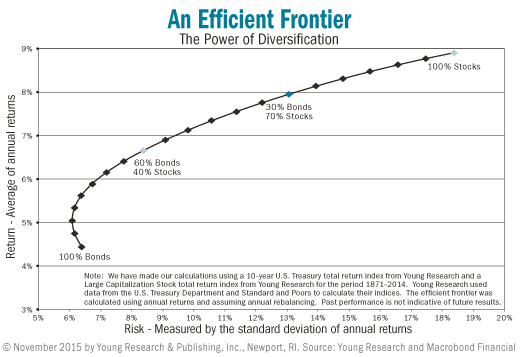In the November issue of Intelligence Report, Dick Young advised investors that his primary motivation is keeping them out of trouble.
My focus, first and foremost, is on keeping you out of trouble. I do not write to needy investors—those who require the financial markets to make something happen to save their bacon—nor to novice investors or rank speculators. If you have been with me over the decades, you know that my primary concern is your comfort and security in your retirement years, whether today or in the future. In other words, my aim is to help you protect and preserve the capital you have acquired over a lifetime. When your working days are over, you no longer have the luxury of rebuilding squandered capital. You have to play out life’s hand with the cards you have been dealt.
Calculating the Efficient Frontier
You need to look at your asset deployment from the top down, focusing on diversification between stocks and bonds. My Efficient Frontier display shows you the power of diversification. Note the left-to-right uphill slanting curve that initiates with a position of 100% bonds and terminates with a position of 100% stocks. We have made our calculations using a 10-year U.S Treasury total return index and a Large Capitalization Stock total return index from Young Research for the period of 1871–2014. We calculate the Efficient Frontier by using annual returns and assuming annual rebalancing.
Draw 1% per Quarter
Where is your best fit along an Efficient Frontier? To answer, you must first establish your ability to absorb risk in the hunt for returns. For decades I have written that in retirement, your target should be a 1% per quarter draw from your portfolio, and not a penny more. This does not mean, however, that you should not position yourself to potentially exceed 1% per quarter returns. Your actual return over any quarter will be controlled largely by the climate of the financial markets at the time, which neither you nor I control. And the climate itself will be determined by the stage of the economic and monetary cycles. I have studied these cycles over five decades and keep you updated regularly. The winter stage of the upside economic and monetary cycle is here, to be followed by a period of discomfort in the economy and the financial markets.

